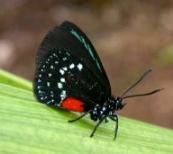Coontie Crazy
 I've decided to publish photographs of life stages for everyone to see what some of you may never have a chance to see in the wild (what's left of it in South Florida!) I'll start with the host plant for the atala, commonly called "coontie." Coontie is a very slow growing cycad and the only cycad native to Florida (Zamia floridana or Z. pumila are the Latin names.) It used to grow throughout the pine rocklands and oak hammocks, but was harvested for flour by the Native Americans, then the early settlers, and then the Industrialists of the early 1900's. By the 1930's, the wild population of coontie was all but eradicated and the butterfly was thought to be extinct! Coontie can still found in isolated pockets in the pinelands, mostly in Miami-Dade County. It can be found at some nurseries that specialize in native plants, however, for butterfly gardens.
I've decided to publish photographs of life stages for everyone to see what some of you may never have a chance to see in the wild (what's left of it in South Florida!) I'll start with the host plant for the atala, commonly called "coontie." Coontie is a very slow growing cycad and the only cycad native to Florida (Zamia floridana or Z. pumila are the Latin names.) It used to grow throughout the pine rocklands and oak hammocks, but was harvested for flour by the Native Americans, then the early settlers, and then the Industrialists of the early 1900's. By the 1930's, the wild population of coontie was all but eradicated and the butterfly was thought to be extinct! Coontie can still found in isolated pockets in the pinelands, mostly in Miami-Dade County. It can be found at some nurseries that specialize in native plants, however, for butterfly gardens.Coontie root is extremely poisonous, containing cycasins, azoxyglucosides and macrozamins (nasty chemicals!) Captain Cook reported several sailors dying from trying to eat improperly processed coontie, so please don't try to make your own flour. Besides, the plant is protected by the federal government, very rare in the wild, and awfully expensive to purchase, as well.
The plant is dioecious, meaning that there are male and female plants. That's a female plant in the upper left hand corner and a male plant in the lower left hand corner. Notice the pollen on the male plant's cone.
People often ask why their coontie seeds don't sprout; often it is because they do not have both a male and female plant. In the wild, there is actually a two-male-to-one-female ratio. This helps assure the plants are pollinated. The female plant develops a short stocky cone, that forms fleshy red seeds. The male plant develops a taller, thinner cone which becomes covered with pollen.
Now another possible reason that the plant doesn't get pollinated is because there is a special and complicated relationship with a weevil known to scientists as Pharaxonotha zamiae. These weevils eat the pollen in the male cones, and occasionally fly out to search of another pollen-bearing cone. They sometimes end up in a female cone instead, thereby pollinating it. If this doesn't sound like a very efficient way of propagating a species, you are so correct! So not only is the cycad slow growing, it's pollination rate isn't as high as most other plants.

And then there is the fact that the seeds contain a germination inhibitor, that must be broken down slowly over the course of the entire year, so that they germinate the spring after they fall from the cone! The good news is that the plant has a sturdy tap root that usually survives the fires that used to sweep through the pine rocklands. They also tolerate the extreme and wet season/dry season cycles, as well as being eaten to the rootstock by atala larvae (caterpillars.)
If you aren't getting fertile seeds from your female coontie, plant two males beside her and hope that the weevils will find them. The more coontie you plant, the more viable your atala population will be. I believe that you must have at least eight to twelve full plants to start a population of atala butterflies, but you will still have to hand-manage the numbers of larvae. A better number of plants would be at least fifty!
Next blog: Atala's Lifestyle.
Now another possible reason that the plant doesn't get pollinated is because there is a special and complicated relationship with a weevil known to scientists as Pharaxonotha zamiae. These weevils eat the pollen in the male cones, and occasionally fly out to search of another pollen-bearing cone. They sometimes end up in a female cone instead, thereby pollinating it. If this doesn't sound like a very efficient way of propagating a species, you are so correct! So not only is the cycad slow growing, it's pollination rate isn't as high as most other plants.

And then there is the fact that the seeds contain a germination inhibitor, that must be broken down slowly over the course of the entire year, so that they germinate the spring after they fall from the cone! The good news is that the plant has a sturdy tap root that usually survives the fires that used to sweep through the pine rocklands. They also tolerate the extreme and wet season/dry season cycles, as well as being eaten to the rootstock by atala larvae (caterpillars.)
If you aren't getting fertile seeds from your female coontie, plant two males beside her and hope that the weevils will find them. The more coontie you plant, the more viable your atala population will be. I believe that you must have at least eight to twelve full plants to start a population of atala butterflies, but you will still have to hand-manage the numbers of larvae. A better number of plants would be at least fifty!
Next blog: Atala's Lifestyle.


0 Comments:
Post a Comment
<< Home